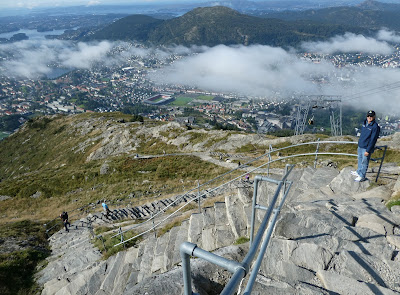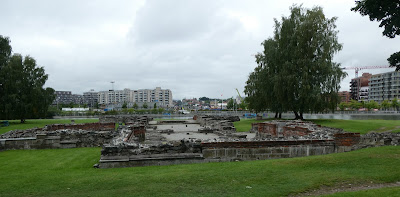When we set out for our Norwegian "vacation" on August 27, we had very few preconceived ideas about what we were going to encounter when we got to Norway. My family background is heavily Scandinavian--mostly Norwegian--and Lon has some Norwegian ancestry on his mom's side, so one of our major travel goals was to have at least one "close encounter of the family kind". That would turn out to be a visit to the farm where a great-grandmother on my mom's side of the family tree was born and raised. Had either of us wanted to spend more time in research we could probably have tracked down more family heritage sites, but this particular ancestor was the easiest option, as other family members had already done the research and identified the farm. The added bonus was that the farm would be relatively easy to get to using mostly public transportation.
The rest of the travel itinerary was built around how we wanted to get to Mo i Rana (the town closest to the former family home) and what we could see and do along the way.
First stop, Oslo, the capitol city of Norway, located on its south coast. It was founded as a city at the end of the Viking Age in 1040, so it's quite an old city, but it currently displays such a modern face that, to us, it didn't feel nearly as old as many of the towns in France of similar age. Blame it, at least in part, on the fact that many of the city's buildings have historically been built of wood. Fourteen fires between Oslo's founding and 1624--when the fire lasted for three days--decimated the city. After the conflagration in 1624, King Christian IV (who jointly ruled Denmark and Norway in those days) ordered the city to be rebuilt closer to Akershus Castle across the bay. Oh, and no ego involved or anything, but he also ordered that the city be renamed "Christiania".
 |
| Approaching Akershus Fortress, brought into service around 1300. Often besieged, it was the official royal residence for several decades in the Middle Ages. It is currently the site of several museums and a royal mausoleum, and still maintains a Norwegian military presence. |
 |
| The castle courtyard. Many of the visible structures are later Renaissance-era additions. |
 |
| View over the harbor from one of the fortress walls. |
 |
| The Grand Hotel. Also known as the site where winners of the Nobel Peace Prize reside. Located on the "main street" of Oslo, Karl Johans Gate. |
 |
| The National Theater. |
 |
| The Norwegian Parliament building, also adjacent to Karl Johans street, and at the opposite end of a park from the National Theater. |
Though it may seem that there are lots and lots of classic buildings, our impression was that they were relatively few and far between. There are many more modern buildings, and the city has been on quite a "tear" this century with respect to an emphasis on modern architecture.
 |
| Lon is about halfway up the lower sloped roof. |
 |
| Not to be outdone, from 2016 we have the "Barcode" project, twelve narrow high-rise buildings of different heights and widths, that together resemble a barcode. |
 |
| The plaza adjacent to the Oslo Central Station. |
 |
| Norwegians love their coffee, which we were happy to see and experience. The hotel breakfast buffets were beyond amazing and with as much strongly brewed coffee as one would care to drink. |
 |
| Part of the shopping zone on Karl Johans street. Downtown seemed to have a healthy retail sector. |
 |
| Only in Norway. The Norwegians like to take advantage of outdoor dining, but a fur wrap on the chair helps with the comfort level on a cool night (or day). |
When Swedish industrialist Alfred Nobel established the five Nobel prizes in his will, he specified that four of the prizes would be given in Sweden, but the Peace Prize was to be administered in Norway. The Peace Prize Center offered a daily walking tour in English that explained the process and took us to all of the venues important to the Peace Prize process.
 |
| The Nobel Peace Center. |
It seemed we had barely arrived in Oslo before we needed to leave on August 30. If Oslo is Norway's "first city" (at least in terms of size, with over 700,000 inhabitants), Bergen (population just under 300,000) is definitely up there in the consciousness of those outside of Norway. Located on the southwest coast of Norway, Bergen is surrounded by mountains and fjords, and has a rich trading history. We knew we wanted to visit Bergen, but wanted to experience some of Norway's vaunted mountain and water scenery while we made our way there. Ultimately, we chose to get there by a combination of railways and a ferry: Oslo to Myrdal via train; the famous "Flam Railway" from Myrdal to Flam; and ferry from Flam to Bergen on the Sognefjord, Norway's longest and deepest fjord. It made for a nearly 13-hour travel day, but aside from a travel delay on the train to Myrdal--which had us wondering if we were going to miss the once-a-day ferry out of Flam--it was not physically strenuous. The biggest danger was in being overwhelmed by how beautiful the scenery could be. You take one or two photos and before you know it you have several hundred pictures of mountains, water, and cute little villages.
 |
| You start out with farms outside of Oslo . . . |
 |
| . . . and before you know it you're in the high mountains. |
 |
| As we descended, I kept imagining what this would look like in January. |
 |
| Some of the landscape flattened out a bit as we approached Bergen at twilight. |
If Oslo is a city with lots of museums and culture, but with some access to nature activities, Bergen is a city with lots of access to nature activities, but with some museums and culture. Bergen is about the same age as Oslo, and served as Norway's capitol in the 13th century. From the end of the 13th century to the end of the 18th, trade was its way of life. In the middle of the 14th century, north German merchants established an outpost of the Hanseatic League in Bergen. Bergen became one of North Europe's largest centers for trade. Bergen's old quayside, Bryggen, is on UNESCO's list of World Heritage Sites. But, as with Oslo, fires were an unfortunate fact of life in this city that also had a plethora of wood buildings. The most devastating fire was in 1702, when 90% of the city was reduced to ashes. But fire was wreaking havoc as late as 1955, when parts of Bryggen burned down. The result is a city with buildings that are mostly relatively recent, and a historic Bryggen district that is a mix of original and totally reconstructed buildings.
 |
| Panorama from Floyen. Our hotel is circled in blue. |
 |
| Just to prove we were there . . . . |
 |
| Headed down in the funicular. Definitely easier on the knees. |
 |
| The source of the crowds around the harbor. Bergen is visited by about 300 cruise ships a year. |
 |
| Haakon's Hall, built in the mid-13th century. It was the largest building of the royal residency when Bergen was the national capitol. |
 |
| St. Mary's Church, the oldest existing building in use in Bergen. Built between 1130 and 1170, it is still an active parish and has been in continuous use since the Middle Ages. |
 |
| The St. Mary's Church pulpit was a gift from German merchants in 1676. The style and construction is unique in Norway. |
 |
| The Bergenhus Fortress was built in the early 1500's. It is one of the oldest and best-preserved stone fortifications in Norway. In WWII, the occupying Germans used it as their western headquarters. |
 |
| Bryggen is primarily tourist shops, but it is interesting to explore the pathways between and behind the buildings. |
 |
| A steep pathway goes down past somewhat older wood-constructed houses. |
 |
| The building on the left is the local McDonald's. |
 |
| We still had some low clouds when we rode up to the top. |
 |
| Once at the top it was beautifully sunny. |
 |
| You can see the walking trail winding its way to the top. It consists of 1333 steps carved out of stone by Sherpas. |
 |
| Lon pauses during his walk down to one of the lower levels-- one with "pause benches." It seems we can't totally resist doing stairs. |
 |
| Lon on top of the world--sort of. |
 |
| Ditto for me. |
 |
| Panorama of Bergen from Mount Ulrike after the clouds finally left. It is the highest of the seven mountains that surround Bergen. |












No comments:
Post a Comment